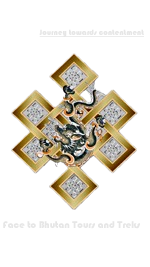Bhutan’s national symbols reflect its rich cultural heritage, Buddhist values, and reverence for nature. Here are the key national symbols of Bhutan:

1. National Flag
- Design: Bhutan’s flag is divided diagonally into two colors – yellow and orange – with a white dragon, the Druk (Thunder Dragon), positioned along the center.
- Symbolism: The yellow represents the secular authority of the king, while the orange symbolizes the country’s spiritual tradition and Buddhist faith. The dragon signifies the name “Druk Yul” (Land of the Thunder Dragon) and symbolizes strength and protection. The jewels in the dragon’s claws represent the country’s wealth and the protection of Bhutanese people.
2. National Emblem
- Design: Bhutan’s national emblem includes a double diamond thunderbolt (dorji) placed above a lotus, flanked by two dragons (one male and one female), all below a jewel.
- Symbolism: The lotus symbolizes purity, the thunderbolt represents harmony between secular and spiritual authority, the dragons indicate the country’s name and sovereignty, and the jewel signifies Bhutan’s wealth and security.
3. National Animal – Takin
- Scientific Name: Budorcas taxicolor
- Characteristics: The takin, a rare and unusual-looking mammal found in Bhutan’s high-altitude regions, resembles a mix between a goat and an antelope.
- Cultural Significance: The takin is associated with a Bhutanese legend involving the Buddhist saint Drukpa Kunley, also known as the “Divine Madman,” who is said to have created the animal with magical powers. It symbolizes the country’s unique biodiversity and connection to myth.
4. National Bird – Raven
- Characteristics: The raven is a highly intelligent bird and plays an important role in Bhutanese history and folklore.
- Cultural Significance: The raven is considered a guardian deity in Bhutan and is associated with Mahakala, a protective deity in Buddhism. It also symbolizes loyalty and protection. The raven is featured on the royal crown of Bhutan, known as the Raven Crown, worn by the Bhutanese kings.
5. National Flower – Blue Poppy
- Scientific Name: Meconopsis grandis
- Characteristics: The blue poppy is a rare and delicate flower with a vibrant blue color, found in the high-altitude areas of the Himalayas.
- Symbolism: The blue poppy represents Bhutan’s mystique, resilience, and beauty. It was once thought to be a mythical flower, discovered only later in Bhutan, adding to its allure and symbolic value.
6. National Tree – Himalayan Cypress
- Scientific Name: Cupressus torulosa
- Characteristics: The Himalayan cypress is a tall evergreen tree that grows abundantly in Bhutan’s mountainous regions.
- Symbolism: The tree represents longevity, resilience, and spirituality. It is often found near monasteries and temples, symbolizing Bhutan’s deep spiritual roots and reverence for nature.
7. National Game – Archery
- Characteristics: Archery is Bhutan’s most popular and traditional sport, with competitions held across the country during festivals and celebrations.
- Cultural Significance: Archery reflects Bhutan’s warrior heritage and its focus on precision and skill. It is often accompanied by songs, dances, and cheer, emphasizing community spirit and camaraderie.
8. National Dress – Gho and Kira
- Gho: The traditional attire for men, a knee-length robe tied with a belt (kera) around the waist.
- Kira: The traditional dress for women, a long, ankle-length dress fastened with a brooch (koma) and worn with a jacket (toego).
- Cultural Significance: Wearing the gho and kira is mandatory in many public settings and is a symbol of Bhutanese identity and cultural pride.
9. National Language – Dzongkha
- Cultural Importance: Dzongkha is the official language of Bhutan and is integral to the country’s heritage. It unifies the Bhutanese people and is taught in schools, helping preserve Bhutan’s unique linguistic identity.
Summary
These symbols encapsulate Bhutan’s values, heritage, and connection to nature and spirituality. They reflect the unique identity of Bhutan and the deep respect for tradition, culture, and the natural world that Bhutanese people cherish.

